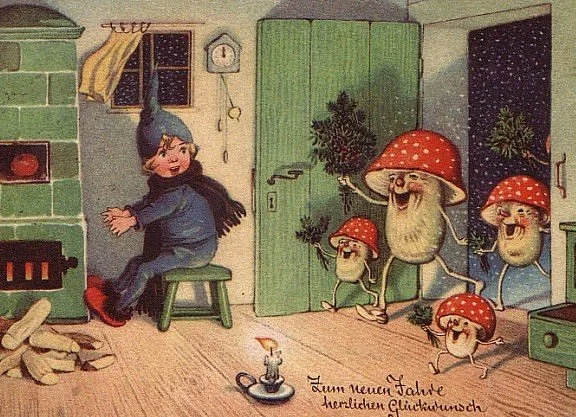Santa Claus is a Mushroom Shaman
Ever wonder why some dude dressed up in red allegedly comes down a chimney once a year from the North Pole to bring people gifts placed under a tree with ball-shaped ornaments hanging from it … on the Winter Solstice? Although widely culturally accepted, nobody ever bats an eye at or questions these seemingly strange traditions. So, could it be that the holiday so famously known as Christmas is actually just a byproduct of Indigenous Siberian & Central Asian psychedelic mushroom culture?
Santa Claus is a Shaman Who Gives Mushroom Gifts Through Chimneys on Winter Solstice
Santa is most famously known wearing that oh so classic red and white outfit - but where did these colors come from? Aside from Coca-Cola’s clear attempt to “brand Santa” and Christmas into consumerism, there is a theory about these colors coming from a famous fungi.
Amanita Muscaria is one of the most potent psychoactive mushrooms known to man. This mushroom’s bright red cap with white spots is recognizable in so many parts of our culture today (think the mushrooms Mario eats to “power up” or even the emoji on your phone’s keyboard). Shamans that worked with A. Muscaria would dress up in red & white outfits with fur linings and black boots in honor of this sacred mushroom while foraging it! And then, they would bring these mushrooms to people in the village as gifts on a very special day - the winter solstice.
“As the story goes, these practicing shamans or priests connected to the older traditions would collect Amanita muscaria (the Holy Mushroom), dry them and then give them as gifts on the winter solstice. Because snow is usually blocking doors [in this part of the world], there was an opening in the roof through which people entered and exited, thus the chimney story,” says Anthropologist John Rush.
Interestingly, Christmas takes place around the winter solstice, a day when many Indigenous communities engage in sacred traditions and ceremonies honoring the natural cycle of the Earth. It’s no coincidence to me that mushrooms which make you contemplate your psychology and existence would be shared as gifts on one of the most energetically potent days of the year.
Christmas Trees & {Mushroom} Ornaments
Anthropologist Rush also makes a claim that pine trees with bright red & white packages under their bough is actually a reference to the exact location that A. Muscaria loves to grow - under the pine bough!
After finding the sacred mushroom under pine trees, the shamans would have to dry them before gifting them to their loved ones. Naturally, they would hang the mushrooms on the branches of these trees to dry out - looking just like those famous ornaments we hang on the pine cut for our homes today!
Flying Reindeer
So, where do these reindeer come from? . . . and why are they flying!? Religious historian Mircea Eliade who specifically studied the roots of shamanism notes that shamans will identify with and develop relationships to spiritual elements of animals in their region. And the reindeer have a very special role to play in this relationship…
Reindeer native to the areas where A. Muscaria grow love this mushroom and eat plenty of it! A. Muscaria can actually be harmful (and sometimes poisonous) for humans to eat raw. Seeing that the reindeer loved it and were safe, shamans would start feeding this mushroom to reindeers with the intention of drinking their urine in order to receive the psychedelic effects of the sacred mushroom without the danger!
Okay, so maybe the reindeer never exactly flew. However, they were essential to the shaman’s ability to travel dimensions.
These are just some of the many arrows pointing to psychedelic red & white mushrooms at the root of Christmas. In Brian Muraresku’s book Immortality Key, he explores Christianity’s psychedelic roots. Perhaps there is a reason that Jesus was born so close to the winter solstice - a time for giving the gift of mushrooms.
Although there is still speculation as to whether or not Christmas really did stem from mushroom practices, I love sharing this story with friends and family gathered around my white tree with mushroom ornaments hanging all around it - honoring the Indigenous practices of Siberia & Central Asia!
I do not recommend ingesting Amanita Muscaria, which is classified as poisonous.


